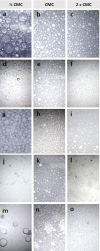Production of cupcake-like dessert containing microbial biosurfactant as an emulsifier
- PMID: 32351793
- PMCID: PMC7183308
- DOI: 10.7717/peerj.9064
Production of cupcake-like dessert containing microbial biosurfactant as an emulsifier
Abstract
This work describes the application of the biosurfactant from Candida bombicola URM 3718 as a meal additive like cupcake. The biosurfactant was produced in a culture medium containing 5% sugar cane molasses, 5% residual soybean oil and 3% corn steep liquor. The surface and interfacial tension of the biosurfactant were 30.790 ± 0.04 mN/m and 0.730 ± 0.05 mN/m, respectively. The yield in isolated biosurfactant was 25 ± 1.02 g/L and the CMC was 0.5 g/L. The emulsions of the isolated biosurfactant with vegetable oils showed satisfactory results. The microphotographs of the emulsions showed that increasing the concentration of biosurfactant decreased the oil droplets, increasing the stability of the emulsions. The biosurfactant was incorporated into the cupcake dessert formulation, replacing 50%, 75% and 100% of the vegetable fat in the standard formulation. Thermal analysis showed that the biosurfactant is stable for cooking cupcakes (180 °C). The biosurfactant proved to be promising for application in foods low in antioxidants and did not show cytotoxic potential in the tested cell lines. Cupcakes with biosurfactant incorporated in their dough did not show significant differences in physical and physical-chemical properties after baking when compared to the standard formulation. In this way, the biosurfactant has potential for application in the food industry as an emulsifier for flour dessert.
Keywords: Bioemulsifiers; Biosurfactants; Candida bombicola; Food technology; Industrial residues.
© 2020 Silva et al.
Conflict of interest statement
The authors declare that they have no competing interests.
Figures




Similar articles
-
Microbial Biosurfactant: Candida bombicola as a Potential Remediator of Environments Contaminated by Heavy Metals.Microorganisms. 2023 Nov 15;11(11):2772. doi: 10.3390/microorganisms11112772. Microorganisms. 2023. PMID: 38004783 Free PMC article.
-
A Biosurfactant from Candida bombicola: Its Synthesis, Characterization, and its Application as a Food Emulsions.Foods. 2022 Feb 16;11(4):561. doi: 10.3390/foods11040561. Foods. 2022. PMID: 35206039 Free PMC article.
-
Potential Food Application of a Biosurfactant Produced by Saccharomyces cerevisiae URM 6670.Front Bioeng Biotechnol. 2020 May 7;8:434. doi: 10.3389/fbioe.2020.00434. eCollection 2020. Front Bioeng Biotechnol. 2020. PMID: 32457894 Free PMC article.
-
Production and potential biotechnological applications of microbial surfactants: An overview.Saudi J Biol Sci. 2021 Jan;28(1):669-679. doi: 10.1016/j.sjbs.2020.10.058. Epub 2020 Nov 4. Saudi J Biol Sci. 2021. PMID: 33424354 Free PMC article. Review.
-
Bioemulsifiers Derived from Microorganisms: Applications in the Drug and Food Industry.Adv Pharm Bull. 2018 Jun;8(2):191-199. doi: 10.15171/apb.2018.023. Epub 2018 Jun 19. Adv Pharm Bull. 2018. PMID: 30023320 Free PMC article. Review.
Cited by
-
Microbial Biosurfactant: Candida bombicola as a Potential Remediator of Environments Contaminated by Heavy Metals.Microorganisms. 2023 Nov 15;11(11):2772. doi: 10.3390/microorganisms11112772. Microorganisms. 2023. PMID: 38004783 Free PMC article.
-
Cookies and muffins containing biosurfactant: textural, physicochemical and sensory analyses.J Food Sci Technol. 2023 Aug;60(8):2180-2192. doi: 10.1007/s13197-023-05745-9. Epub 2023 Apr 21. J Food Sci Technol. 2023. PMID: 37273570 Free PMC article.
-
An insight into the utilization of microbial biosurfactants pertaining to their industrial applications in the food sector.Food Sci Biotechnol. 2023 Nov 30;33(2):245-273. doi: 10.1007/s10068-023-01435-6. eCollection 2024 Jan. Food Sci Biotechnol. 2023. PMID: 38222912 Free PMC article. Review.
-
Biotechnological potential of microbial bio-surfactants, their significance, and diverse applications.FEMS Microbes. 2023 Aug 10;4:xtad015. doi: 10.1093/femsmc/xtad015. eCollection 2023. FEMS Microbes. 2023. PMID: 37614639 Free PMC article. Review.
-
Biosurfactants: Forthcomings and Regulatory Affairs in Food-Based Industries.Molecules. 2023 Mar 21;28(6):2823. doi: 10.3390/molecules28062823. Molecules. 2023. PMID: 36985795 Free PMC article. Review.
References
-
- Akbari S, Abdurahman NH, Yunus RM, Fayaz F, Alara OR. Biosurfactants—a new frontier for social and environmental safety: a mini review. Biotechnology Research and Innovation. 2018;2(1):81–90. doi: 10.1016/j.biori.2018.09.001. - DOI
-
- AOAC . Official method of analysis. 17th Edition. Washington, D.C.: Association of Official Analytical Chemists; 2002.
-
- Bandyopadhyay K, Chakraborty C, Bhattacharyya S. Fortification of mango peel and kernel powder in cookies formulation. Journal of Academia and Industrial Research. 2014;2(12):661–664.
Grants and funding
LinkOut - more resources
Full Text Sources

